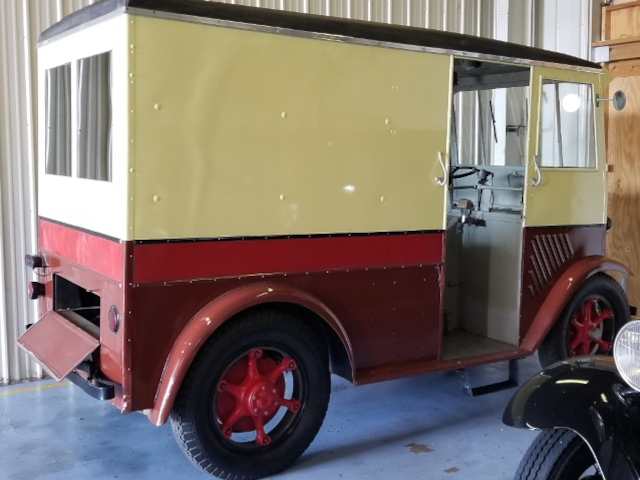I knew about this truck since 2007. Bif Florey, Jr told me about it while he was working with me to restore my 1938 Walker D-500 gas/electric truck. Since Bif’s Dad was the chief electrical engineer for the Thorne Truck company, Bif Jr keep up on these old trucks and knew where most of the survivors were. As a matter of fact, Bif worked on this truck in 1999 and got it running for the owner at that time.
This truck was owned for a long time by a family in The Pittsburgh, Pa. area. The owner died and the family held an Estate sale. An automobile restorer bought this truck. His cousin is a neighbor of mine and he sent me a picture of the truck telling me that his cousin just bought this truck. So he thought since it was a milk truck I might be interested in seeing a picture of this truck. To make a long story short, after I saw the picture of this truck, I contacted his cousin and bought the truck. The truck had been restored in the late 1990’s. I have decided not to do any further restoration to the truck and leave it as I bought it. The truck will now be preserved for future generations to see and enjoy along with the rest of my “Stand & Drive” Truck Exhibit.
Thorne Gas/Electric Trucks
Thorne Motor Corporation was formed in 1928, and a factory was built on Chicago’s west side. The first prototype was built by the cut-and-fit method because an engineering staff had not yet been formed. It ‘performed well and 25 of the original design were built and sold.
The Thorne Gas-Electric was assembled with readily available components; engine by Continental, wheels and axles by Clark Equipment Co., 4-wheel hydraulic brakes by Lockheed,
and electrical equipment was made to specs by Hertner in Cleveland. lt was the ultimate in quality, performance and efficiency. There was nothing that was equal to it. lt did not take long for the dairy industry to recognize the value of the Thorne Gas-Electrics, and placed orders for these trucks.
Many of the dairies purchased two or three trucks for test and then ordered several more. Some dairies operated a fleet of exclusively Thorne Gas-Electrics because they were more durable than any other make of truck and cost less to maintain.
The B-1 introduced in 1929 was the bread and butter of Thorne Motors. They sold hundreds. The engine was a 173 cid 4 cylinder Buda manufactured nearby in Harvey, lllinois. The electricals came from Hertner Electric of Cleveland, who picked up the pieces when Thorne went bust in 1932. The later versions of B-1 ‘s sported three windshield panes.
The B-2 was designed and introduced in Chicago in 1932 to be a little more stylish, and to also go back to Continental engines. A number were built and sold but the Great Depression took the wind out of Thorne Motors and they folded, and what was left transferred to Hertner Electric its largest creditor. Production resumed in Cleveland in 1933 in a truck-at-a time hand to mouth operation.
The Hertner B-3 was introduced late in 1933. This was their hallmark product. lt looked like a Thorne B-2 but featured a 6 cylinder 201 cid Chrysler Amplex industrial strength engine that gave the truck markedly better performance. The target market shifted to the hill country of New York and Pennsylvania. Earlier Thornes did fine in the plains of Ohio, Indiana and Illinois, but struggled in the hills. Just not enough power. The Amplex solved that problem.
Hertner had to face the moment of truth. Hertner simply could not produce the demand orders for their trucks. This was 1936 and things were not looking up because of the deep depression. lt was either make a very heavy investment to stay in business. So it was Put up or Shut down time. And so the curtain fell quickly. Hertner delivered standing orders until 1937 then closed shop.


